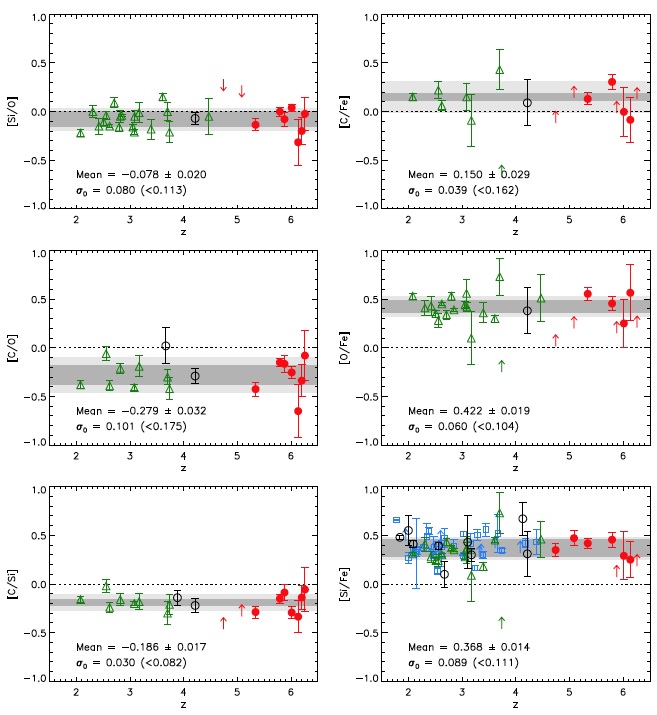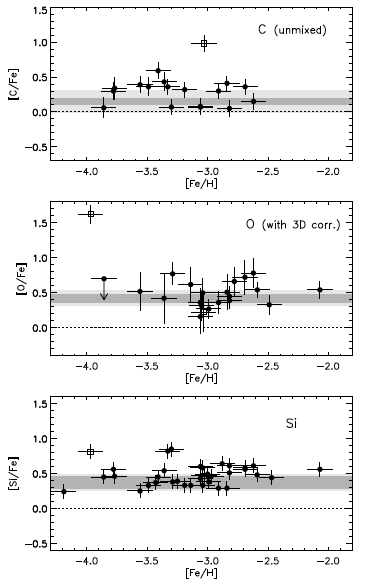Title: Iron and alpha-element production in the first one billion years after the Big Bang
Authors: George Becker, Wallace Sargent, Michael Rauch, Robert Carswell
First Author’s Affiliation: Kavli Institute for Cosmology and Institute of Astronomy, Cambridge
The study of the chemical enrichment history of the Universe is like a family reunion at Thanksgiving: it delightfully brings together stellar and extragalactic astronomers, observers and theorists, cosmologists and exoplaneteers*, and despite fundamental philosophical differences and oppositely polarized views of the world, everyone can agree that the food is delicious. This agreement is not particularly surprising, given that our solar system, our planet, even our bodies are composed of “star stuff.” Since it’s a holiday, I’m going to take a moment to digress and reminisce a bit. Do you remember the first time you learned that the elements that make up literally EVERYTHING we see and interact with, all the organic and inorganic compounds, (almost) everything besides the gas in the ill-fated Hindenberg and gas that makes you talk in a squeaky voice, was generated in the interiors of stars? It made me realize for the first time just how incredibly HUGE – in a way that 3.09×1018 centimeters just can’t imply – the Universe is, and how small a part of it we humans are. It was also the moment I decided I was going to pursue astronomy as a career. I’m sure some of you have other interesting stories, and I hope you’ll share them by posting a comment below.
A Brief Elemental Review
The commonly accepted paradigm of chemical enrichment history is essentially the following. At the dawn of the Universe, Big Bang Nucleosynthesis produced only hydrogen, helium, and very trace amounts of lithium and beryllium. The first stars to form from this primordial soup – commonly called “Population III stars” – were thought to be disproportionately very massive and short-lived, and they quickly seeded the (then-much-smaller) Universe with the first heavier elements. Subsequent generations of stars formed with increasingly higher metallicity as the most massive of them rapidly evolved and further enriched the gas through supernovae. Other enrichment channels, such as planetary nebula ejecta from intermediate-mass stars, type Ia supernovae, and winds from evolved stars, also contributed to chemical evolution. The end result is that we see a Universe today that is in general more metal-rich than it used to be. However, we observe an incredibly wide range of metallicity across various environments, and figuring out the details has proven to be immensely complicated. Most studies of chemical enrichment have focused on either very old (and metal-poor) stars in the Milky Way, or on gas at high redshift. This paper compares observations across redshifts from 0 to 6.3 – a staggering range of cosmic time spanning practically the entire history of the Universe.
The authors observed nine high-redshift quasar systems and used their absorption spectra to study the material along our line of sight (see Ian’s recent astrobite for another report of quasar absorption spectra at high redshift). Quasars are the most intrinsically luminous persistent objects in the Universe: powered by accretion onto supermassive black holes at the centers of distant galaxies, their light travels across unfathomable distances before reaching us here today. They are of course inherently very interesting, but their incredible luminosity also allows them to be used as “cosmic flashlights.” Atoms and molecules in intervening gas clouds absorb some of the quasar’s continuum emission, leaving features with characteristic shapes and at specific wavelengths based on the cloud’s chemical abundance and distance, allowing us to study the chemical properties of the distant interstellar and intergalactic medium. On cosmic scales, the expansion of the Universe (a.k.a. the “Hubble flow”) causes even light to be stretched. The quasars in this study are so far away that the Hubble flow is carrying them away from us at nearly the speed of light, and by the time their light reaches us, its wavelength has increased by a factor of 5 to 7!
Results
The absorption systems detected toward the quasars in this study allowed the authors to measure column densities (the total integrated quantity along a line of sight) of ionized carbon, silicon, and iron (C II, Si II, Fe II) and neutral oxygen (O I), and thus infer the abundances of these elements. These specific ionization states are the lowest for each element that have an ionization potential greater than that of ground-state hydrogen (13.6 eV); since the clouds are optically thick to photons with E = hν > 13.6 eV, and diffuse enough that collisional excitation does not play a major role, the overwhelming majority of atoms of these elements will be in the ground states of these particular ionization states. Therefore, studying a single transition is a direct measure of the column density, and thus the abundance. The authors compare their results for z > 4.7 to element ratios in lower-redshift damped Lyman-α absorption systems (DLAs; absorption systems with hydrogen column densities ≥ 1020 atoms cm-2 ), and find that (1) relative abundances are similar, and (2) the intrinsic scatter is very small (see Figure 1). These DLAs are likely to be lower-redshift counterparts to the dataset presented in the paper. Abundance ratios are compared because they are less sensitive to systematic effects than absolute abundances.

Figure 1: Relative abundances for the quasar absorption systems in this study (red circles) compared to those from three separate samples of lower redshift, low-metallicity damped Lyman-α systems (DLAs). All ratios show a remarkable consistency across a wide range of redshifts (which corresponds to a period of time when the Universe was between about 1 and 3 billion years old).
Implications
The metal content of these ancient systems reflects the yields of very early massive stars, as there had not been sufficient time for any of the other enrichment channels to become effective. Here, the word “yield” refers to the amount of chemical processing (mostly due to nuclear fusion) that occurred in the star during its lifetime, and thus represents a quantitative measure of the overall increase in the gas-phase abundance of various elements. Furthermore, the fact that abundance ratios do not change in the ensuing few billion years suggests that prompt supernovae continued to dominate enrichment as the Universe grew and aged. The authors also infer from their data that all supernovae of massive stars produce material having an iron-to-oxygen ratio of about one-third of the solar value.
Intriguingly, the abundances of metal-poor stars in the Milky Way also generally agree with those in the distant quasar absorption systems (see Figure 2), providing further evidence that these stars indeed formed very early on in the Universe’s evolution. This remarkable consistency over nearly the entire history of the Universe suggests that the chemical state of the gas in the systems studied in this paper is not actually all that different from that in lower-redshift gas in the DLAs and in low-metallicity stars observed today. The authors point out that this could mean that by z~6, Population II stars had “taken over” the Universe, and that they — not massive Population III stars — produced the majority of the ionizing photons responsible for the epoch of reionization.

Figure 2: α-element abundances vs. metallicity for a sample of metal-poor halo stars. The dark grey bands indicate the 1-σ scatter around the mean from the quasar absorption data in this paper.
So remember as you go for that second plate of turkey to be thankful for massive stars, for in a very real sense they provided the food on your table. Happy Thanksgiving!
*this may or may not actually be a word.

Trackbacks/Pingbacks